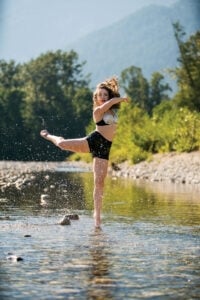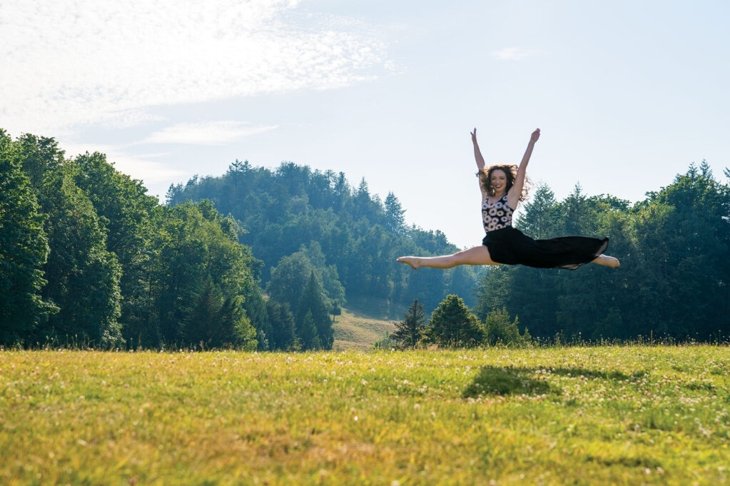
As ancient as fire, dance has always been a part of human culture. It’s at the core of rituals and celebrations all over the globe. Everyone can benefit from experiencing the heartbeat of dance, especially kids.
\”Think of the magic of that foot, comparatively small, upon which your whole weight rests. It’s a miracle. And the dance is a celebration of that miracle.\”
—Martha Graham
Tamara Dawson took her first dance class when she was just three. She went on to compete and train internationally for many years, having learned everything from modern and jazz to hip hop and street dance. Dawson credits one of her first ballet instructors with helping her discover her passion.
“She made it magical for me,” recalls Dawson, who currently teaches adults. “We were dancing around like fairies and walking like princesses. It was this magical place.”
As she honed her skills, Dawson learned much more than pointe technique and lyrical gestures; she realized that dance was a way for her to convey her feelings.
“I remember I walked into ballet class one time and my instructor looked at me and knew I was a complete mess,” Dawson recalls. “She looked straight at me and said, ‘Whatever is going on in your life, I want you to express it in your dancing.’ All of a sudden, I became super emotional and started expressing it in my dance. It was so powerful. So many people want to push it [emotion] down.
“You can feel your creativity bubble up from all the things you’ve experienced, and it’s the best feeling in the world,” she says. “It’s your release.”
 Dance as natural movement
Dance as natural movement
As ancient as fire, dance has always been a part of human culture. It’s at the core of rituals and celebrations all over the globe. Whether people dedicate their careers to the craft or simply like to bust moves at home, everyone can benefit from experiencing the heartbeat of dance.
Kids in particular have a special connection to the form: born dancers, they explore the world and express themselves through movement before they even learn to walk.
Marian Rose, a dance educator based in Quebec, is the founder of the Community Dance Project, through which she teaches week-long intensive workshops in schools. She focuses on forms such as folk, square, and social dance to get families and communities moving together to music in a spirit of celebration.
“Even people who start the week reluctant or uncomfortable are screaming for more at the end,” Rose says, adding that kids learn all sorts of different things through dance, beyond basic steps. “There’s tons of mathematics in dancing: geometry and patterning. Kids learn language arts too: I show them a dance; then they have to write down what they saw.”
Rose, who’s been teaching dance since the 1990s, says that two themes come up repeatedly when she asks people what got them interested in dance as children: they had parents who were enthusiastic about dancing or a charismatic teacher who transmitted an infectious love of the form to them.
Dance as confidence booster
Now one of those inspirational teachers herself, Alix Dunham was five when she started going to her local ballet school—and kept going even though one of her teachers called her “Bambi on ice.” The founder of the Pink Petal Ballet School in North Vancouver turned to modern dance in her twenties.
“I was drawn to dance because I was a pretty awkward kid,” Dunham says. “In some ways, dance made me feel beautiful, gave me confidence, and tapped into a part of me that I couldn’t express any other way. Today, I love watching someone bare their soul through awesome physicality.
“Getting kids involved in dance is an awesome way to promote self-confidence, discipline, and creativity,” she adds. “It’s especially valuable for kids who are pre-verbal or who are dealing with special needs or learning disorders, because it allows them to express themselves physically and provides an outlet for expression.”
Dance as pure fun
When getting children started in dance, the worst thing parents can do is push too hard. “Dance should be a lifelong love, and kids will be turned off if their first experience with dance is negative,” Dunham says. “I would suggest parents keep dance super fun, positive, and pretty casual until they are seven or eight. At that point, if the child decides it’s their passion, then dance can start to be taken seriously.”
Dunham says, “Search out a dance instructor or school that will nurture your child’s growing soul with love and confidence-building warmth.”
 Dance is for everyone
Dance is for everyone
Having grown up doing karate in Sherwood Park, Alberta, Shay Kuebler switched directions when he was 12. Wanting to foster his creative side, he signed up for a hip-hop class. By the time he was 14, he was teaching and choreographing.
“Dance was a combination of being able to do something really physical, but it was also about being able to create a story and perform,” says Kuebler, who’s now based in Vancouver and heads his own company, Shay Kuebler Radical System Art. He says that while he experienced some teasing from other kids about dancing—especially when he took ballet—he didn’t let it get to him.
“There were always kids that thought it was weird that I danced,” he says. “I did get flak for being a dancer, but I would go to workshops and meet people from all over the world. So many [of] dancers were male, it made me realize that the world is bigger than just school. It gave me a greater perspective.”
“It’s a tough thing, but the reality is, it’s so important for kids to be passionate about something,” he says. “That passion and dedication helps them become better people.”
For Kuebler, dance has helped him be more humble, due to the toll the activity takes on the body. It has also helped improve his interpersonal relationships. “Being a performer, choreographer, and director, I try to be more compassionate and understanding of other people,” he says.
To help keep young boys engaged in dance, Kuebler says it helps to find a studio or school that has male role models. And if boys are being subjected to taunting at school or pressure by peers to give it up, he suggests surrounding them with a positive, nurturing community. “My parents and close circle of friends really gave me encouragement and a lot of love and helped me continue on my path,” he says.
Dance as soul food
Jyla Davis wasn’t always a dancer. When she started doing gymnastics as a preschooler, Davis was so adept at the sport that coaches told her parents she should train for the Olympics. Yet while the moves came naturally to her, the Ladner, BC, native wasn’t having much fun. The gym was intimidating, the activity too intense.
In Grade 2, a friend asked her to come to a dance class. She fell in love with the form and, now 33, has been dancing ever since. Davis competed for many years, has trained and performed around the world, and has appeared in movies and on TV shows. Her craft has contributed far more to her life than professional success, however.
“Dance has taught me so much,” says Davis, owner and director of Studio West Dance in Delta, BC, a school with more than 400 students of all ages. “You learn how to respect yourself, how to be confident, how to be responsible for yourself and your body.
“It’s physical activity, it’s art, it’s therapy,” she adds. “It’s so good for the soul.”
Trendy dance styles for kids
Acro
With flips, aerial moves, and handstands, this highly athletic form blends dance technique with gymnastics.
Bollywood
Jai ho! Incorporating Indian and Western influences, this style is a fun workout.
Musical theatre
Broadway, here we come: the form incorporates music, song, dialogue, and movement.
Popular types of dance for kids
Whatever type of dance you choose, Jyla Davis of Studio West Dance says, “Give it at least four classes. Sometimes it can be the style kids don’t like, or it could just be the other kids in the class. Don’t be shy to ask the teacher questions.
“Dance is such an amazing activity for so many kids: it brings out their confidence, their personality; it lets them feel music and be expressive. They learn to be respectful and to have discipline.”
Ballet
The classical form provides the fundamentals of dance.
Jazz
With a focus on syncopation and self-expression, jazz helps kids develop flexibility and improvisational skills.
Hip hop
Merging funk, street dance, pop ’n’ locking, and breakdancing, this is a great style for high-energy kids.
How to get kids interested in dance
Have weekly dance parties
Plug in your iPod for a dance party in your living room. It doesn’t matter what the moves look like; just put on some upbeat tunes and dance the night away. “Make it something regular so that dance isn’t this weird thing that other people do,” Rose says. “It’s so important that children see adults doing it.”
Model a love of dance
Hit the dance floor at family weddings, register for a dance class yourself, and take kids to fun shows such as STOMP! Boys in particular may be encouraged by seeing African or Ukrainian dance performances, which tend to feature men prominently.
Help kids express themselves through movement
Whether your child is feeling happy, sad, or worried, have them try to show what their feelings look like by moving their body rather than using words.



